Financial Accounting Report: Final Accounts and Bank Reconciliation
VerifiedAdded on 2023/01/18
|12
|3295
|41
Report
AI Summary
This report on financial accounting delves into the preparation of final accounts for both sole proprietorships and limited companies, including income statements and balance sheets. It explores the differences between these statements and provides a hypothetical example of a bank reconciliation statement, detailing the process of reconciling bank and company records. Furthermore, the report examines the reconciliation of control and suspense accounts, crucial for maintaining accurate financial records. The content includes practical examples and explanations, aiming to provide a clear understanding of key accounting concepts and their application in financial analysis and reporting. The report also discusses the importance of these processes in ensuring the accuracy and reliability of financial data, essential for informed decision-making by stakeholders.

FINANCIAL
ACCOUNTING
ACCOUNTING
Paraphrase This Document
Need a fresh take? Get an instant paraphrase of this document with our AI Paraphraser
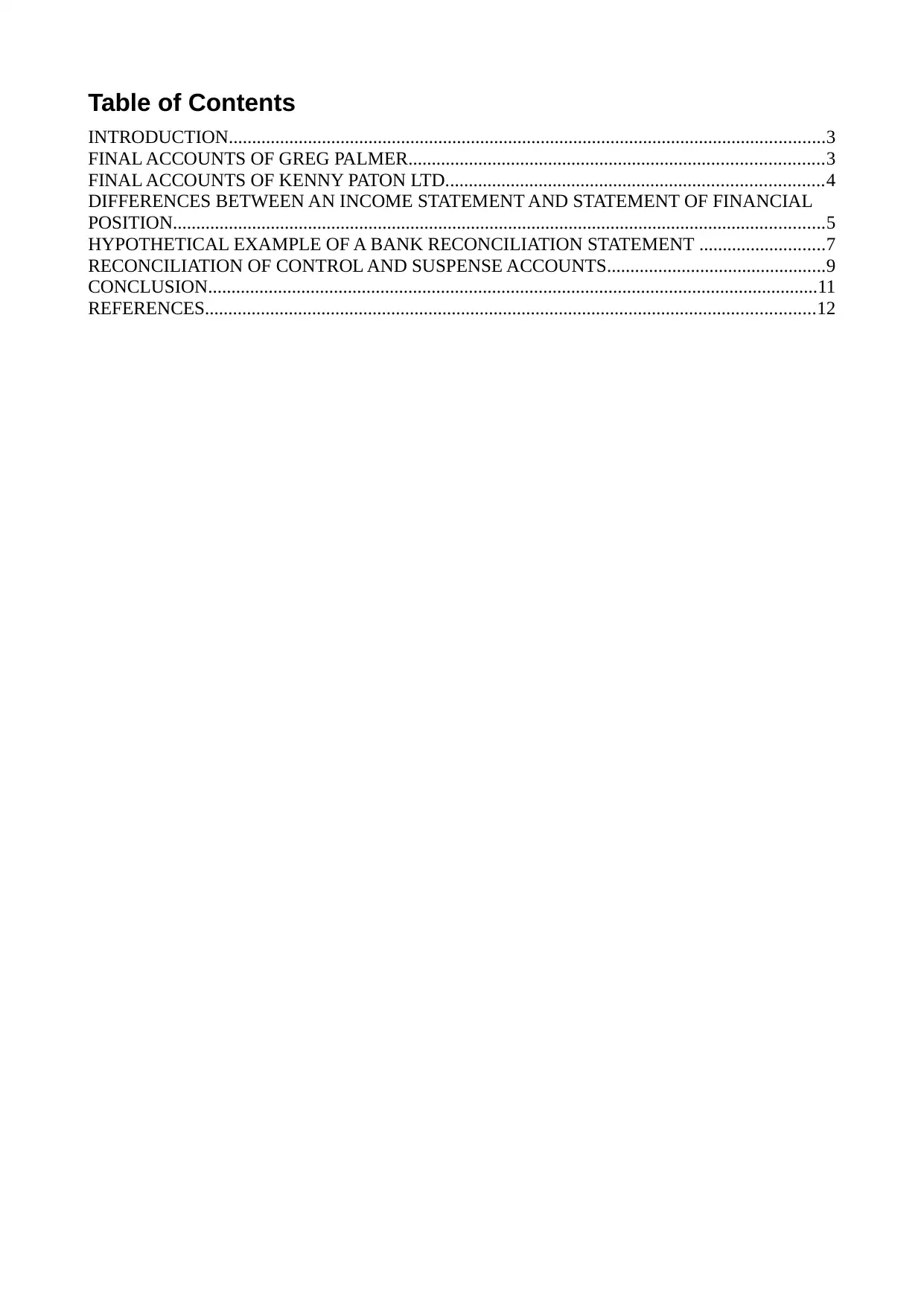
Table of Contents
INTRODUCTION................................................................................................................................3
FINAL ACCOUNTS OF GREG PALMER.........................................................................................3
FINAL ACCOUNTS OF KENNY PATON LTD.................................................................................4
DIFFERENCES BETWEEN AN INCOME STATEMENT AND STATEMENT OF FINANCIAL
POSITION............................................................................................................................................5
HYPOTHETICAL EXAMPLE OF A BANK RECONCILIATION STATEMENT ...........................7
RECONCILIATION OF CONTROL AND SUSPENSE ACCOUNTS...............................................9
CONCLUSION...................................................................................................................................11
REFERENCES...................................................................................................................................12
INTRODUCTION................................................................................................................................3
FINAL ACCOUNTS OF GREG PALMER.........................................................................................3
FINAL ACCOUNTS OF KENNY PATON LTD.................................................................................4
DIFFERENCES BETWEEN AN INCOME STATEMENT AND STATEMENT OF FINANCIAL
POSITION............................................................................................................................................5
HYPOTHETICAL EXAMPLE OF A BANK RECONCILIATION STATEMENT ...........................7
RECONCILIATION OF CONTROL AND SUSPENSE ACCOUNTS...............................................9
CONCLUSION...................................................................................................................................11
REFERENCES...................................................................................................................................12
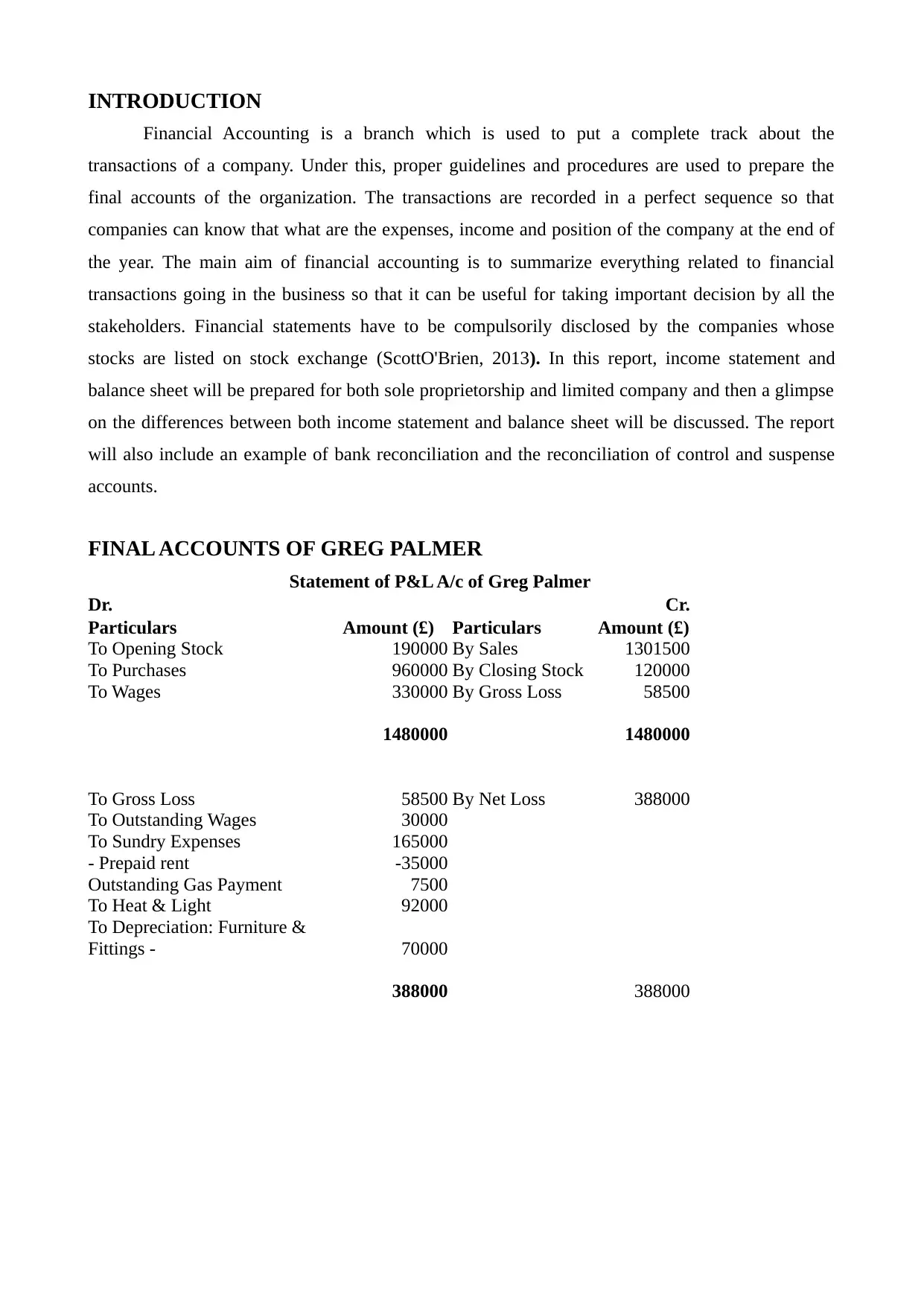
INTRODUCTION
Financial Accounting is a branch which is used to put a complete track about the
transactions of a company. Under this, proper guidelines and procedures are used to prepare the
final accounts of the organization. The transactions are recorded in a perfect sequence so that
companies can know that what are the expenses, income and position of the company at the end of
the year. The main aim of financial accounting is to summarize everything related to financial
transactions going in the business so that it can be useful for taking important decision by all the
stakeholders. Financial statements have to be compulsorily disclosed by the companies whose
stocks are listed on stock exchange (ScottO'Brien, 2013). In this report, income statement and
balance sheet will be prepared for both sole proprietorship and limited company and then a glimpse
on the differences between both income statement and balance sheet will be discussed. The report
will also include an example of bank reconciliation and the reconciliation of control and suspense
accounts.
FINAL ACCOUNTS OF GREG PALMER
Statement of P&L A/c of Greg Palmer
Dr. Cr.
Particulars Amount (£) Particulars Amount (£)
To Opening Stock 190000 By Sales 1301500
To Purchases 960000 By Closing Stock 120000
To Wages 330000 By Gross Loss 58500
1480000 1480000
To Gross Loss 58500 By Net Loss 388000
To Outstanding Wages 30000
To Sundry Expenses 165000
- Prepaid rent -35000
Outstanding Gas Payment 7500
To Heat & Light 92000
To Depreciation: Furniture &
Fittings - 70000
388000 388000
Financial Accounting is a branch which is used to put a complete track about the
transactions of a company. Under this, proper guidelines and procedures are used to prepare the
final accounts of the organization. The transactions are recorded in a perfect sequence so that
companies can know that what are the expenses, income and position of the company at the end of
the year. The main aim of financial accounting is to summarize everything related to financial
transactions going in the business so that it can be useful for taking important decision by all the
stakeholders. Financial statements have to be compulsorily disclosed by the companies whose
stocks are listed on stock exchange (ScottO'Brien, 2013). In this report, income statement and
balance sheet will be prepared for both sole proprietorship and limited company and then a glimpse
on the differences between both income statement and balance sheet will be discussed. The report
will also include an example of bank reconciliation and the reconciliation of control and suspense
accounts.
FINAL ACCOUNTS OF GREG PALMER
Statement of P&L A/c of Greg Palmer
Dr. Cr.
Particulars Amount (£) Particulars Amount (£)
To Opening Stock 190000 By Sales 1301500
To Purchases 960000 By Closing Stock 120000
To Wages 330000 By Gross Loss 58500
1480000 1480000
To Gross Loss 58500 By Net Loss 388000
To Outstanding Wages 30000
To Sundry Expenses 165000
- Prepaid rent -35000
Outstanding Gas Payment 7500
To Heat & Light 92000
To Depreciation: Furniture &
Fittings - 70000
388000 388000
⊘ This is a preview!⊘
Do you want full access?
Subscribe today to unlock all pages.

Trusted by 1+ million students worldwide
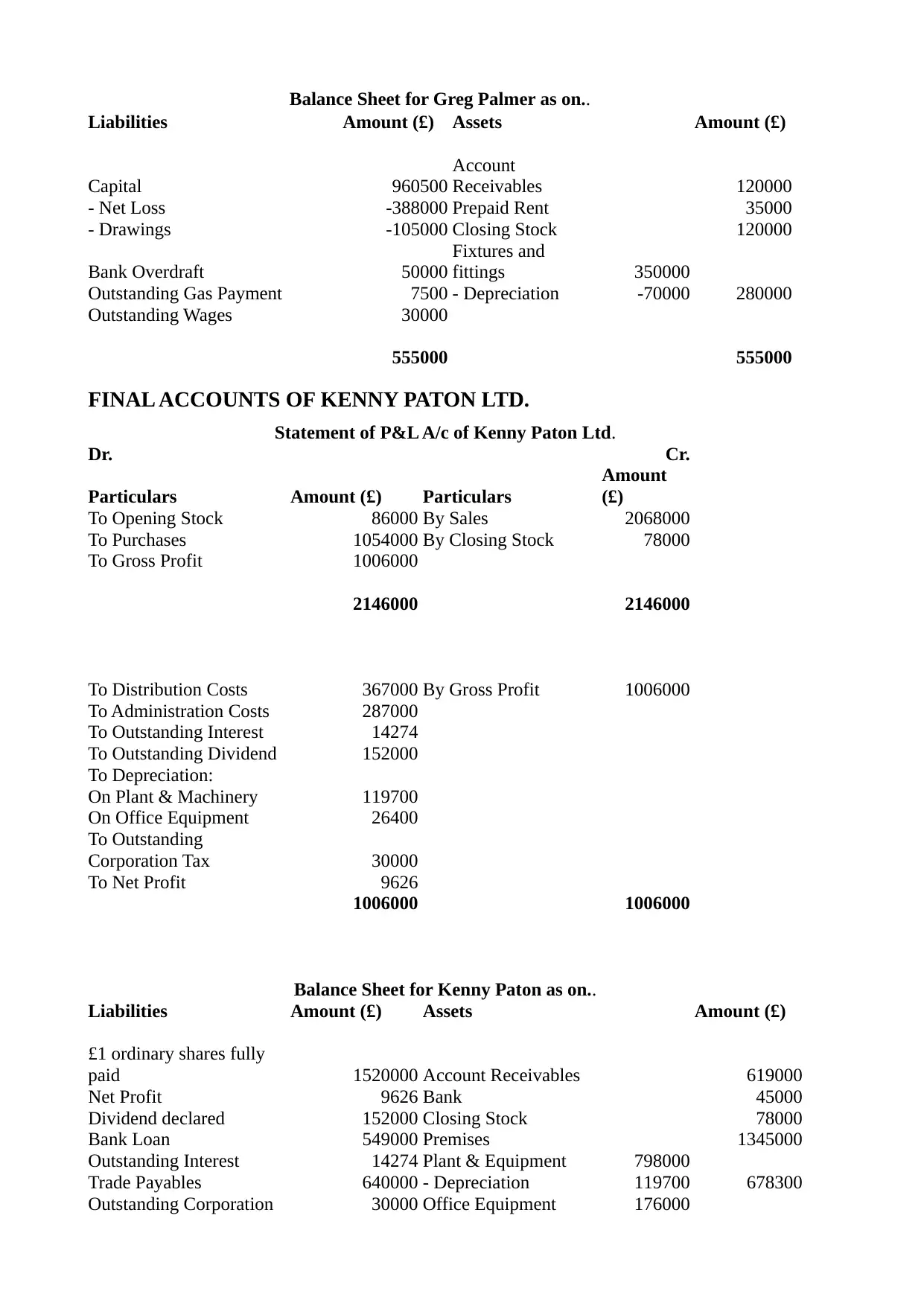
Balance Sheet for Greg Palmer as on..
Liabilities Amount (£) Assets Amount (£)
Capital 960500
Account
Receivables 120000
- Net Loss -388000 Prepaid Rent 35000
- Drawings -105000 Closing Stock 120000
Bank Overdraft 50000
Fixtures and
fittings 350000
Outstanding Gas Payment 7500 - Depreciation -70000 280000
Outstanding Wages 30000
555000 555000
FINAL ACCOUNTS OF KENNY PATON LTD.
Statement of P&L A/c of Kenny Paton Ltd.
Dr. Cr.
Particulars Amount (£) Particulars
Amount
(£)
To Opening Stock 86000 By Sales 2068000
To Purchases 1054000 By Closing Stock 78000
To Gross Profit 1006000
2146000 2146000
To Distribution Costs 367000 By Gross Profit 1006000
To Administration Costs 287000
To Outstanding Interest 14274
To Outstanding Dividend 152000
To Depreciation:
On Plant & Machinery 119700
On Office Equipment 26400
To Outstanding
Corporation Tax 30000
To Net Profit 9626
1006000 1006000
Balance Sheet for Kenny Paton as on..
Liabilities Amount (£) Assets Amount (£)
£1 ordinary shares fully
paid 1520000 Account Receivables 619000
Net Profit 9626 Bank 45000
Dividend declared 152000 Closing Stock 78000
Bank Loan 549000 Premises 1345000
Outstanding Interest 14274 Plant & Equipment 798000
Trade Payables 640000 - Depreciation 119700 678300
Outstanding Corporation 30000 Office Equipment 176000
Liabilities Amount (£) Assets Amount (£)
Capital 960500
Account
Receivables 120000
- Net Loss -388000 Prepaid Rent 35000
- Drawings -105000 Closing Stock 120000
Bank Overdraft 50000
Fixtures and
fittings 350000
Outstanding Gas Payment 7500 - Depreciation -70000 280000
Outstanding Wages 30000
555000 555000
FINAL ACCOUNTS OF KENNY PATON LTD.
Statement of P&L A/c of Kenny Paton Ltd.
Dr. Cr.
Particulars Amount (£) Particulars
Amount
(£)
To Opening Stock 86000 By Sales 2068000
To Purchases 1054000 By Closing Stock 78000
To Gross Profit 1006000
2146000 2146000
To Distribution Costs 367000 By Gross Profit 1006000
To Administration Costs 287000
To Outstanding Interest 14274
To Outstanding Dividend 152000
To Depreciation:
On Plant & Machinery 119700
On Office Equipment 26400
To Outstanding
Corporation Tax 30000
To Net Profit 9626
1006000 1006000
Balance Sheet for Kenny Paton as on..
Liabilities Amount (£) Assets Amount (£)
£1 ordinary shares fully
paid 1520000 Account Receivables 619000
Net Profit 9626 Bank 45000
Dividend declared 152000 Closing Stock 78000
Bank Loan 549000 Premises 1345000
Outstanding Interest 14274 Plant & Equipment 798000
Trade Payables 640000 - Depreciation 119700 678300
Outstanding Corporation 30000 Office Equipment 176000
Paraphrase This Document
Need a fresh take? Get an instant paraphrase of this document with our AI Paraphraser
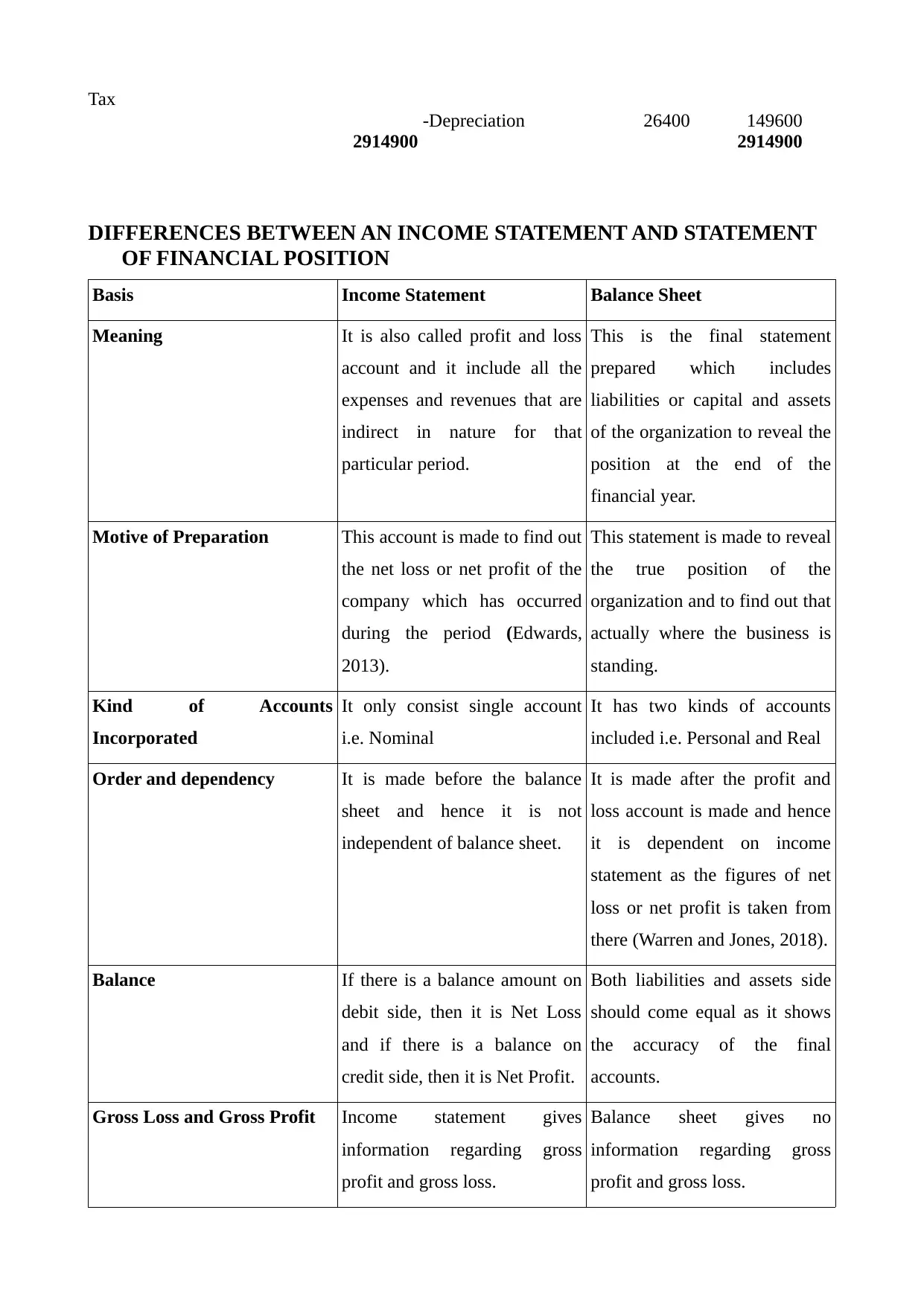
Tax
-Depreciation 26400 149600
2914900 2914900
DIFFERENCES BETWEEN AN INCOME STATEMENT AND STATEMENT
OF FINANCIAL POSITION
Basis Income Statement Balance Sheet
Meaning It is also called profit and loss
account and it include all the
expenses and revenues that are
indirect in nature for that
particular period.
This is the final statement
prepared which includes
liabilities or capital and assets
of the organization to reveal the
position at the end of the
financial year.
Motive of Preparation This account is made to find out
the net loss or net profit of the
company which has occurred
during the period (Edwards,
2013).
This statement is made to reveal
the true position of the
organization and to find out that
actually where the business is
standing.
Kind of Accounts
Incorporated
It only consist single account
i.e. Nominal
It has two kinds of accounts
included i.e. Personal and Real
Order and dependency It is made before the balance
sheet and hence it is not
independent of balance sheet.
It is made after the profit and
loss account is made and hence
it is dependent on income
statement as the figures of net
loss or net profit is taken from
there (Warren and Jones, 2018).
Balance If there is a balance amount on
debit side, then it is Net Loss
and if there is a balance on
credit side, then it is Net Profit.
Both liabilities and assets side
should come equal as it shows
the accuracy of the final
accounts.
Gross Loss and Gross Profit Income statement gives
information regarding gross
profit and gross loss.
Balance sheet gives no
information regarding gross
profit and gross loss.
-Depreciation 26400 149600
2914900 2914900
DIFFERENCES BETWEEN AN INCOME STATEMENT AND STATEMENT
OF FINANCIAL POSITION
Basis Income Statement Balance Sheet
Meaning It is also called profit and loss
account and it include all the
expenses and revenues that are
indirect in nature for that
particular period.
This is the final statement
prepared which includes
liabilities or capital and assets
of the organization to reveal the
position at the end of the
financial year.
Motive of Preparation This account is made to find out
the net loss or net profit of the
company which has occurred
during the period (Edwards,
2013).
This statement is made to reveal
the true position of the
organization and to find out that
actually where the business is
standing.
Kind of Accounts
Incorporated
It only consist single account
i.e. Nominal
It has two kinds of accounts
included i.e. Personal and Real
Order and dependency It is made before the balance
sheet and hence it is not
independent of balance sheet.
It is made after the profit and
loss account is made and hence
it is dependent on income
statement as the figures of net
loss or net profit is taken from
there (Warren and Jones, 2018).
Balance If there is a balance amount on
debit side, then it is Net Loss
and if there is a balance on
credit side, then it is Net Profit.
Both liabilities and assets side
should come equal as it shows
the accuracy of the final
accounts.
Gross Loss and Gross Profit Income statement gives
information regarding gross
profit and gross loss.
Balance sheet gives no
information regarding gross
profit and gross loss.
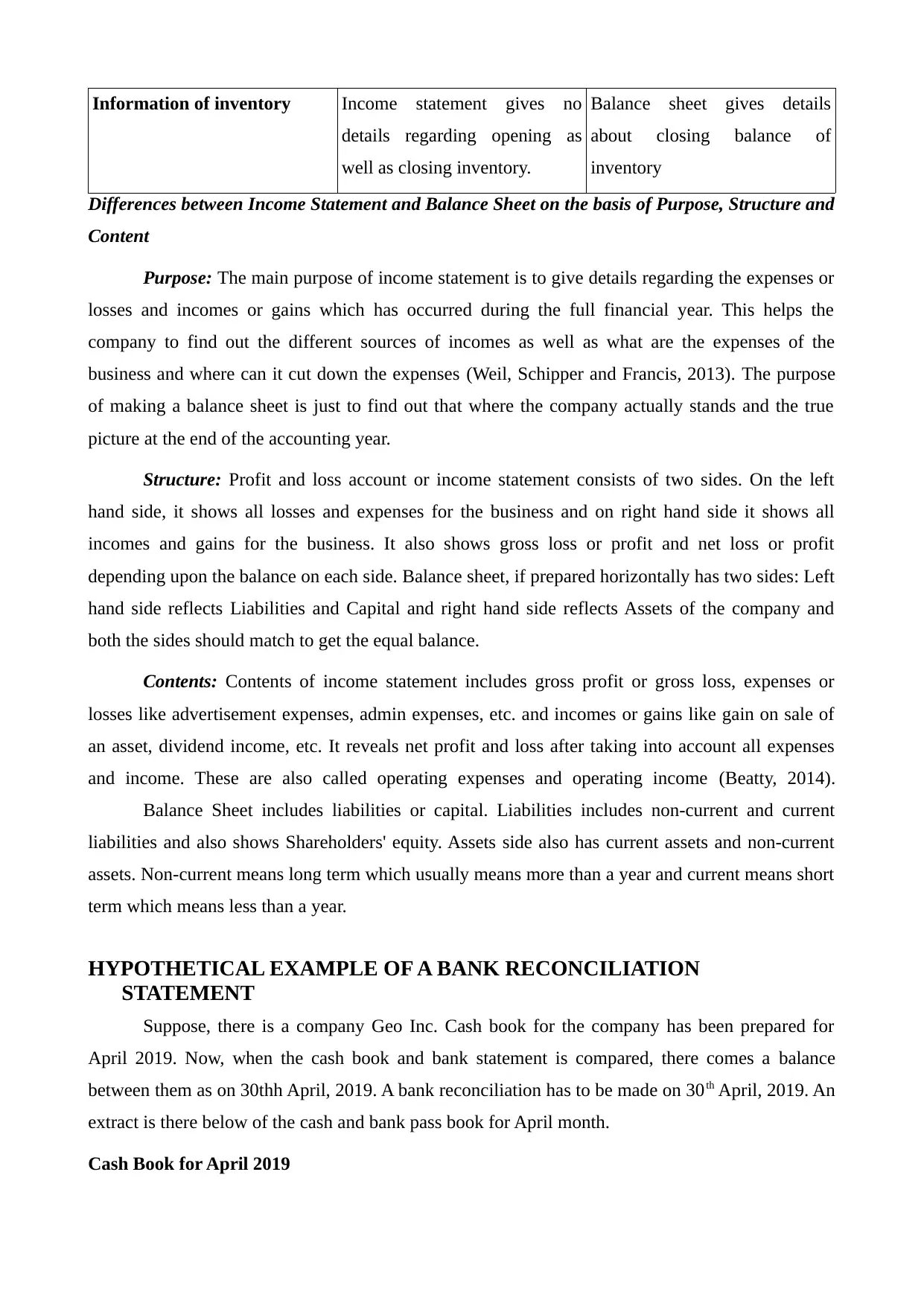
Information of inventory Income statement gives no
details regarding opening as
well as closing inventory.
Balance sheet gives details
about closing balance of
inventory
Differences between Income Statement and Balance Sheet on the basis of Purpose, Structure and
Content
Purpose: The main purpose of income statement is to give details regarding the expenses or
losses and incomes or gains which has occurred during the full financial year. This helps the
company to find out the different sources of incomes as well as what are the expenses of the
business and where can it cut down the expenses (Weil, Schipper and Francis, 2013). The purpose
of making a balance sheet is just to find out that where the company actually stands and the true
picture at the end of the accounting year.
Structure: Profit and loss account or income statement consists of two sides. On the left
hand side, it shows all losses and expenses for the business and on right hand side it shows all
incomes and gains for the business. It also shows gross loss or profit and net loss or profit
depending upon the balance on each side. Balance sheet, if prepared horizontally has two sides: Left
hand side reflects Liabilities and Capital and right hand side reflects Assets of the company and
both the sides should match to get the equal balance.
Contents: Contents of income statement includes gross profit or gross loss, expenses or
losses like advertisement expenses, admin expenses, etc. and incomes or gains like gain on sale of
an asset, dividend income, etc. It reveals net profit and loss after taking into account all expenses
and income. These are also called operating expenses and operating income (Beatty, 2014).
Balance Sheet includes liabilities or capital. Liabilities includes non-current and current
liabilities and also shows Shareholders' equity. Assets side also has current assets and non-current
assets. Non-current means long term which usually means more than a year and current means short
term which means less than a year.
HYPOTHETICAL EXAMPLE OF A BANK RECONCILIATION
STATEMENT
Suppose, there is a company Geo Inc. Cash book for the company has been prepared for
April 2019. Now, when the cash book and bank statement is compared, there comes a balance
between them as on 30thh April, 2019. A bank reconciliation has to be made on 30th April, 2019. An
extract is there below of the cash and bank pass book for April month.
Cash Book for April 2019
details regarding opening as
well as closing inventory.
Balance sheet gives details
about closing balance of
inventory
Differences between Income Statement and Balance Sheet on the basis of Purpose, Structure and
Content
Purpose: The main purpose of income statement is to give details regarding the expenses or
losses and incomes or gains which has occurred during the full financial year. This helps the
company to find out the different sources of incomes as well as what are the expenses of the
business and where can it cut down the expenses (Weil, Schipper and Francis, 2013). The purpose
of making a balance sheet is just to find out that where the company actually stands and the true
picture at the end of the accounting year.
Structure: Profit and loss account or income statement consists of two sides. On the left
hand side, it shows all losses and expenses for the business and on right hand side it shows all
incomes and gains for the business. It also shows gross loss or profit and net loss or profit
depending upon the balance on each side. Balance sheet, if prepared horizontally has two sides: Left
hand side reflects Liabilities and Capital and right hand side reflects Assets of the company and
both the sides should match to get the equal balance.
Contents: Contents of income statement includes gross profit or gross loss, expenses or
losses like advertisement expenses, admin expenses, etc. and incomes or gains like gain on sale of
an asset, dividend income, etc. It reveals net profit and loss after taking into account all expenses
and income. These are also called operating expenses and operating income (Beatty, 2014).
Balance Sheet includes liabilities or capital. Liabilities includes non-current and current
liabilities and also shows Shareholders' equity. Assets side also has current assets and non-current
assets. Non-current means long term which usually means more than a year and current means short
term which means less than a year.
HYPOTHETICAL EXAMPLE OF A BANK RECONCILIATION
STATEMENT
Suppose, there is a company Geo Inc. Cash book for the company has been prepared for
April 2019. Now, when the cash book and bank statement is compared, there comes a balance
between them as on 30thh April, 2019. A bank reconciliation has to be made on 30th April, 2019. An
extract is there below of the cash and bank pass book for April month.
Cash Book for April 2019
⊘ This is a preview!⊘
Do you want full access?
Subscribe today to unlock all pages.

Trusted by 1+ million students worldwide
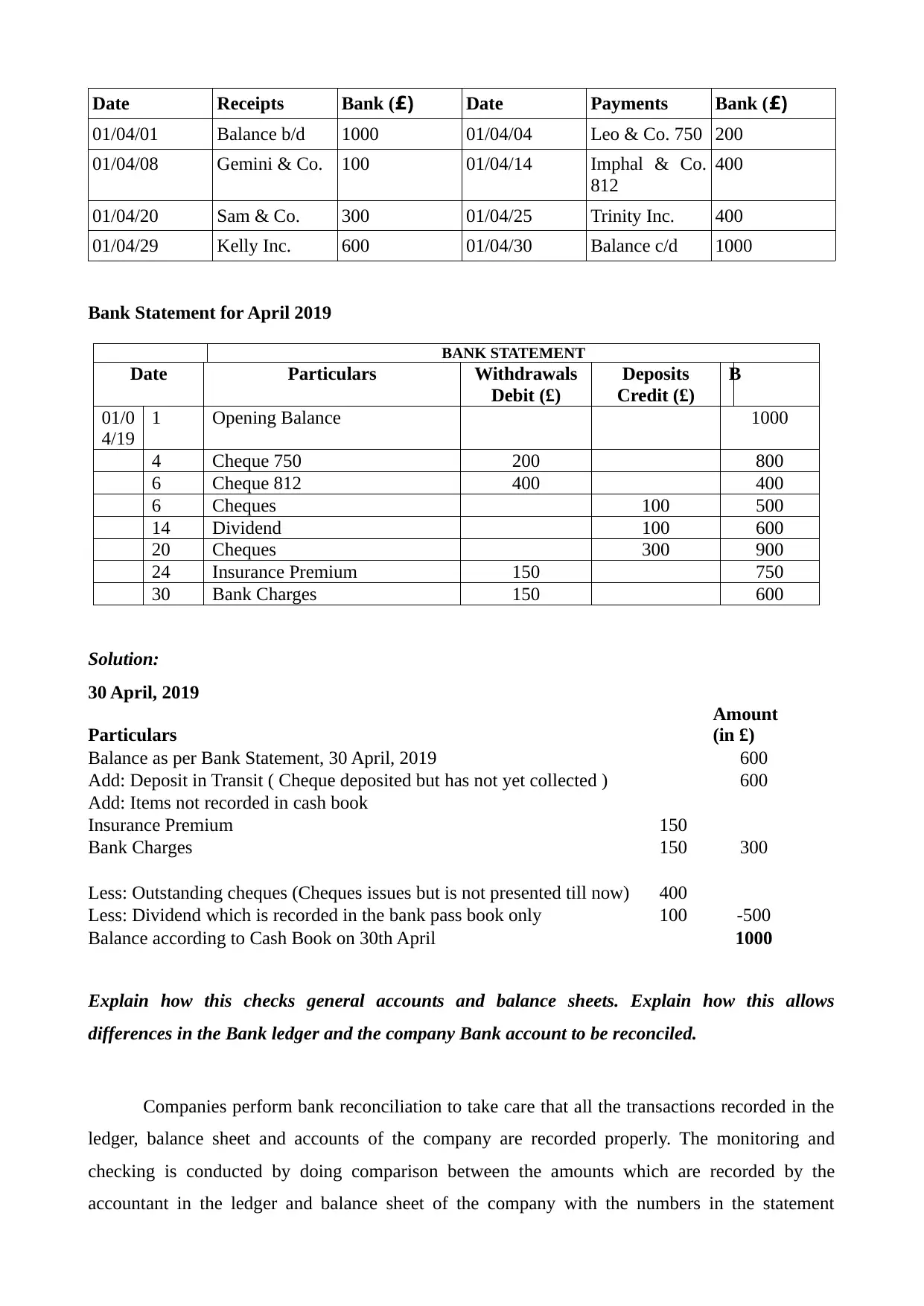
Date Receipts Bank (£) Date Payments Bank (£)
01/04/01 Balance b/d 1000 01/04/04 Leo & Co. 750 200
01/04/08 Gemini & Co. 100 01/04/14 Imphal & Co.
812
400
01/04/20 Sam & Co. 300 01/04/25 Trinity Inc. 400
01/04/29 Kelly Inc. 600 01/04/30 Balance c/d 1000
Bank Statement for April 2019
BANK STATEMENT
Date Particulars Withdrawals
Debit (£)
Deposits
Credit (£)
B
01/0
4/19
1 Opening Balance 1000
4 Cheque 750 200 800
6 Cheque 812 400 400
6 Cheques 100 500
14 Dividend 100 600
20 Cheques 300 900
24 Insurance Premium 150 750
30 Bank Charges 150 600
Solution:
30 April, 2019
Particulars
Amount
(in £)
Balance as per Bank Statement, 30 April, 2019 600
Add: Deposit in Transit ( Cheque deposited but has not yet collected ) 600
Add: Items not recorded in cash book
Insurance Premium 150
Bank Charges 150 300
Less: Outstanding cheques (Cheques issues but is not presented till now) 400
Less: Dividend which is recorded in the bank pass book only 100 -500
Balance according to Cash Book on 30th April 1000
Explain how this checks general accounts and balance sheets. Explain how this allows
differences in the Bank ledger and the company Bank account to be reconciled.
Companies perform bank reconciliation to take care that all the transactions recorded in the
ledger, balance sheet and accounts of the company are recorded properly. The monitoring and
checking is conducted by doing comparison between the amounts which are recorded by the
accountant in the ledger and balance sheet of the company with the numbers in the statement
01/04/01 Balance b/d 1000 01/04/04 Leo & Co. 750 200
01/04/08 Gemini & Co. 100 01/04/14 Imphal & Co.
812
400
01/04/20 Sam & Co. 300 01/04/25 Trinity Inc. 400
01/04/29 Kelly Inc. 600 01/04/30 Balance c/d 1000
Bank Statement for April 2019
BANK STATEMENT
Date Particulars Withdrawals
Debit (£)
Deposits
Credit (£)
B
01/0
4/19
1 Opening Balance 1000
4 Cheque 750 200 800
6 Cheque 812 400 400
6 Cheques 100 500
14 Dividend 100 600
20 Cheques 300 900
24 Insurance Premium 150 750
30 Bank Charges 150 600
Solution:
30 April, 2019
Particulars
Amount
(in £)
Balance as per Bank Statement, 30 April, 2019 600
Add: Deposit in Transit ( Cheque deposited but has not yet collected ) 600
Add: Items not recorded in cash book
Insurance Premium 150
Bank Charges 150 300
Less: Outstanding cheques (Cheques issues but is not presented till now) 400
Less: Dividend which is recorded in the bank pass book only 100 -500
Balance according to Cash Book on 30th April 1000
Explain how this checks general accounts and balance sheets. Explain how this allows
differences in the Bank ledger and the company Bank account to be reconciled.
Companies perform bank reconciliation to take care that all the transactions recorded in the
ledger, balance sheet and accounts of the company are recorded properly. The monitoring and
checking is conducted by doing comparison between the amounts which are recorded by the
accountant in the ledger and balance sheet of the company with the numbers in the statement
Paraphrase This Document
Need a fresh take? Get an instant paraphrase of this document with our AI Paraphraser
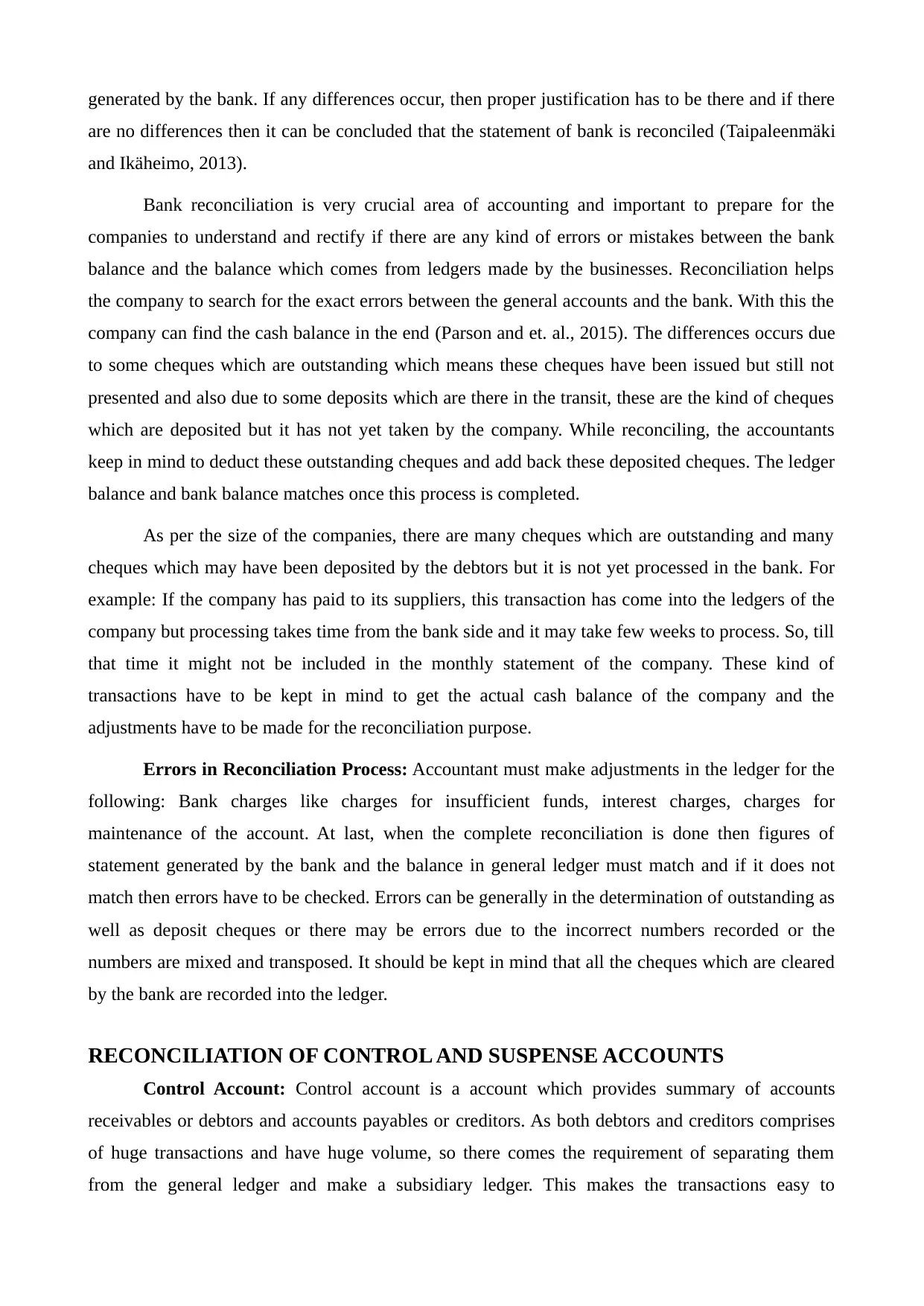
generated by the bank. If any differences occur, then proper justification has to be there and if there
are no differences then it can be concluded that the statement of bank is reconciled (Taipaleenmäki
and Ikäheimo, 2013).
Bank reconciliation is very crucial area of accounting and important to prepare for the
companies to understand and rectify if there are any kind of errors or mistakes between the bank
balance and the balance which comes from ledgers made by the businesses. Reconciliation helps
the company to search for the exact errors between the general accounts and the bank. With this the
company can find the cash balance in the end (Parson and et. al., 2015). The differences occurs due
to some cheques which are outstanding which means these cheques have been issued but still not
presented and also due to some deposits which are there in the transit, these are the kind of cheques
which are deposited but it has not yet taken by the company. While reconciling, the accountants
keep in mind to deduct these outstanding cheques and add back these deposited cheques. The ledger
balance and bank balance matches once this process is completed.
As per the size of the companies, there are many cheques which are outstanding and many
cheques which may have been deposited by the debtors but it is not yet processed in the bank. For
example: If the company has paid to its suppliers, this transaction has come into the ledgers of the
company but processing takes time from the bank side and it may take few weeks to process. So, till
that time it might not be included in the monthly statement of the company. These kind of
transactions have to be kept in mind to get the actual cash balance of the company and the
adjustments have to be made for the reconciliation purpose.
Errors in Reconciliation Process: Accountant must make adjustments in the ledger for the
following: Bank charges like charges for insufficient funds, interest charges, charges for
maintenance of the account. At last, when the complete reconciliation is done then figures of
statement generated by the bank and the balance in general ledger must match and if it does not
match then errors have to be checked. Errors can be generally in the determination of outstanding as
well as deposit cheques or there may be errors due to the incorrect numbers recorded or the
numbers are mixed and transposed. It should be kept in mind that all the cheques which are cleared
by the bank are recorded into the ledger.
RECONCILIATION OF CONTROL AND SUSPENSE ACCOUNTS
Control Account: Control account is a account which provides summary of accounts
receivables or debtors and accounts payables or creditors. As both debtors and creditors comprises
of huge transactions and have huge volume, so there comes the requirement of separating them
from the general ledger and make a subsidiary ledger. This makes the transactions easy to
are no differences then it can be concluded that the statement of bank is reconciled (Taipaleenmäki
and Ikäheimo, 2013).
Bank reconciliation is very crucial area of accounting and important to prepare for the
companies to understand and rectify if there are any kind of errors or mistakes between the bank
balance and the balance which comes from ledgers made by the businesses. Reconciliation helps
the company to search for the exact errors between the general accounts and the bank. With this the
company can find the cash balance in the end (Parson and et. al., 2015). The differences occurs due
to some cheques which are outstanding which means these cheques have been issued but still not
presented and also due to some deposits which are there in the transit, these are the kind of cheques
which are deposited but it has not yet taken by the company. While reconciling, the accountants
keep in mind to deduct these outstanding cheques and add back these deposited cheques. The ledger
balance and bank balance matches once this process is completed.
As per the size of the companies, there are many cheques which are outstanding and many
cheques which may have been deposited by the debtors but it is not yet processed in the bank. For
example: If the company has paid to its suppliers, this transaction has come into the ledgers of the
company but processing takes time from the bank side and it may take few weeks to process. So, till
that time it might not be included in the monthly statement of the company. These kind of
transactions have to be kept in mind to get the actual cash balance of the company and the
adjustments have to be made for the reconciliation purpose.
Errors in Reconciliation Process: Accountant must make adjustments in the ledger for the
following: Bank charges like charges for insufficient funds, interest charges, charges for
maintenance of the account. At last, when the complete reconciliation is done then figures of
statement generated by the bank and the balance in general ledger must match and if it does not
match then errors have to be checked. Errors can be generally in the determination of outstanding as
well as deposit cheques or there may be errors due to the incorrect numbers recorded or the
numbers are mixed and transposed. It should be kept in mind that all the cheques which are cleared
by the bank are recorded into the ledger.
RECONCILIATION OF CONTROL AND SUSPENSE ACCOUNTS
Control Account: Control account is a account which provides summary of accounts
receivables or debtors and accounts payables or creditors. As both debtors and creditors comprises
of huge transactions and have huge volume, so there comes the requirement of separating them
from the general ledger and make a subsidiary ledger. This makes the transactions easy to
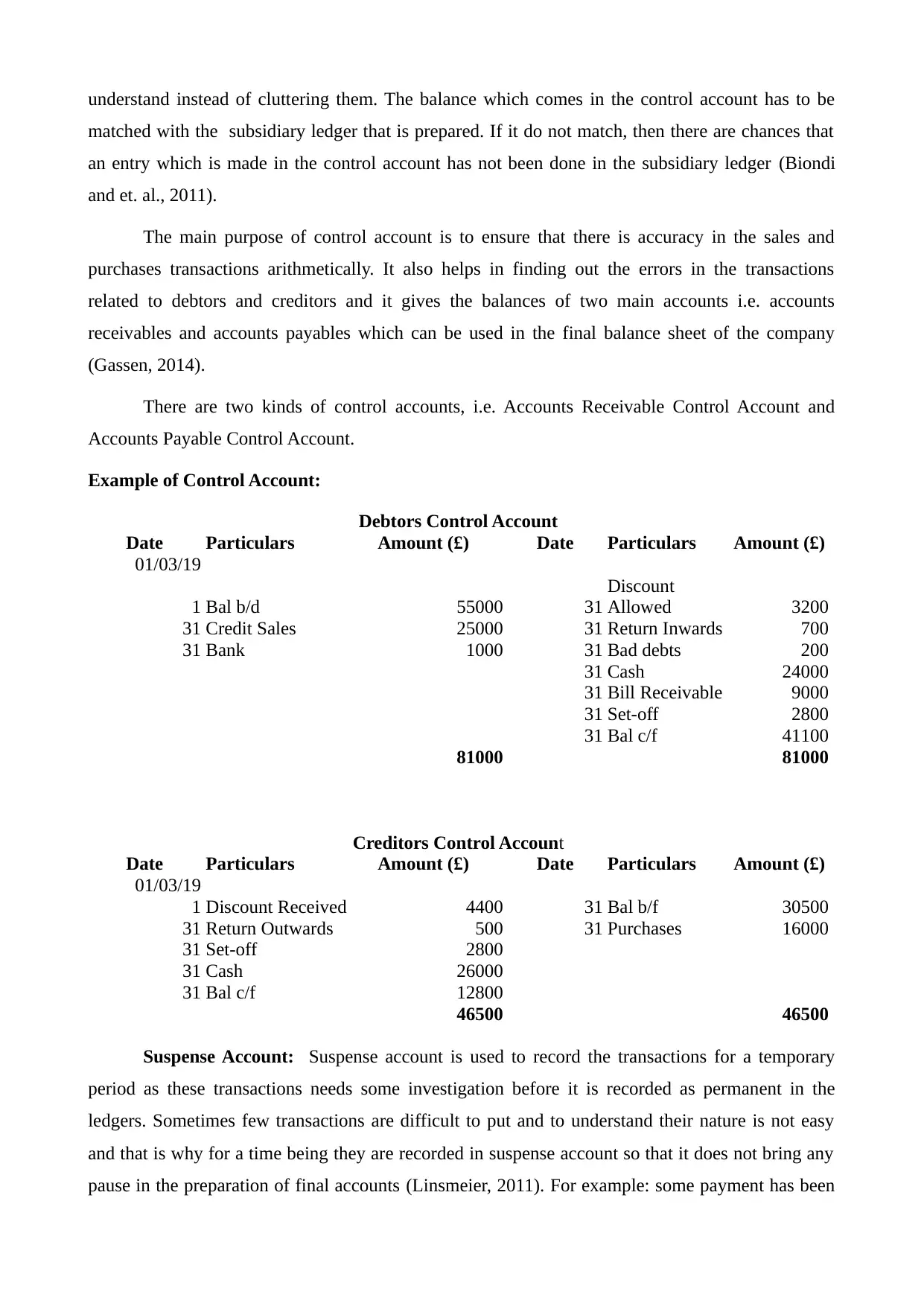
understand instead of cluttering them. The balance which comes in the control account has to be
matched with the subsidiary ledger that is prepared. If it do not match, then there are chances that
an entry which is made in the control account has not been done in the subsidiary ledger (Biondi
and et. al., 2011).
The main purpose of control account is to ensure that there is accuracy in the sales and
purchases transactions arithmetically. It also helps in finding out the errors in the transactions
related to debtors and creditors and it gives the balances of two main accounts i.e. accounts
receivables and accounts payables which can be used in the final balance sheet of the company
(Gassen, 2014).
There are two kinds of control accounts, i.e. Accounts Receivable Control Account and
Accounts Payable Control Account.
Example of Control Account:
Debtors Control Account
Date Particulars Amount (£) Date Particulars Amount (£)
01/03/19
1 Bal b/d 55000 31
Discount
Allowed 3200
31 Credit Sales 25000 31 Return Inwards 700
31 Bank 1000 31 Bad debts 200
31 Cash 24000
31 Bill Receivable 9000
31 Set-off 2800
31 Bal c/f 41100
81000 81000
Creditors Control Account
Date Particulars Amount (£) Date Particulars Amount (£)
01/03/19
1 Discount Received 4400 31 Bal b/f 30500
31 Return Outwards 500 31 Purchases 16000
31 Set-off 2800
31 Cash 26000
31 Bal c/f 12800
46500 46500
Suspense Account: Suspense account is used to record the transactions for a temporary
period as these transactions needs some investigation before it is recorded as permanent in the
ledgers. Sometimes few transactions are difficult to put and to understand their nature is not easy
and that is why for a time being they are recorded in suspense account so that it does not bring any
pause in the preparation of final accounts (Linsmeier, 2011). For example: some payment has been
matched with the subsidiary ledger that is prepared. If it do not match, then there are chances that
an entry which is made in the control account has not been done in the subsidiary ledger (Biondi
and et. al., 2011).
The main purpose of control account is to ensure that there is accuracy in the sales and
purchases transactions arithmetically. It also helps in finding out the errors in the transactions
related to debtors and creditors and it gives the balances of two main accounts i.e. accounts
receivables and accounts payables which can be used in the final balance sheet of the company
(Gassen, 2014).
There are two kinds of control accounts, i.e. Accounts Receivable Control Account and
Accounts Payable Control Account.
Example of Control Account:
Debtors Control Account
Date Particulars Amount (£) Date Particulars Amount (£)
01/03/19
1 Bal b/d 55000 31
Discount
Allowed 3200
31 Credit Sales 25000 31 Return Inwards 700
31 Bank 1000 31 Bad debts 200
31 Cash 24000
31 Bill Receivable 9000
31 Set-off 2800
31 Bal c/f 41100
81000 81000
Creditors Control Account
Date Particulars Amount (£) Date Particulars Amount (£)
01/03/19
1 Discount Received 4400 31 Bal b/f 30500
31 Return Outwards 500 31 Purchases 16000
31 Set-off 2800
31 Cash 26000
31 Bal c/f 12800
46500 46500
Suspense Account: Suspense account is used to record the transactions for a temporary
period as these transactions needs some investigation before it is recorded as permanent in the
ledgers. Sometimes few transactions are difficult to put and to understand their nature is not easy
and that is why for a time being they are recorded in suspense account so that it does not bring any
pause in the preparation of final accounts (Linsmeier, 2011). For example: some payment has been
⊘ This is a preview!⊘
Do you want full access?
Subscribe today to unlock all pages.

Trusted by 1+ million students worldwide
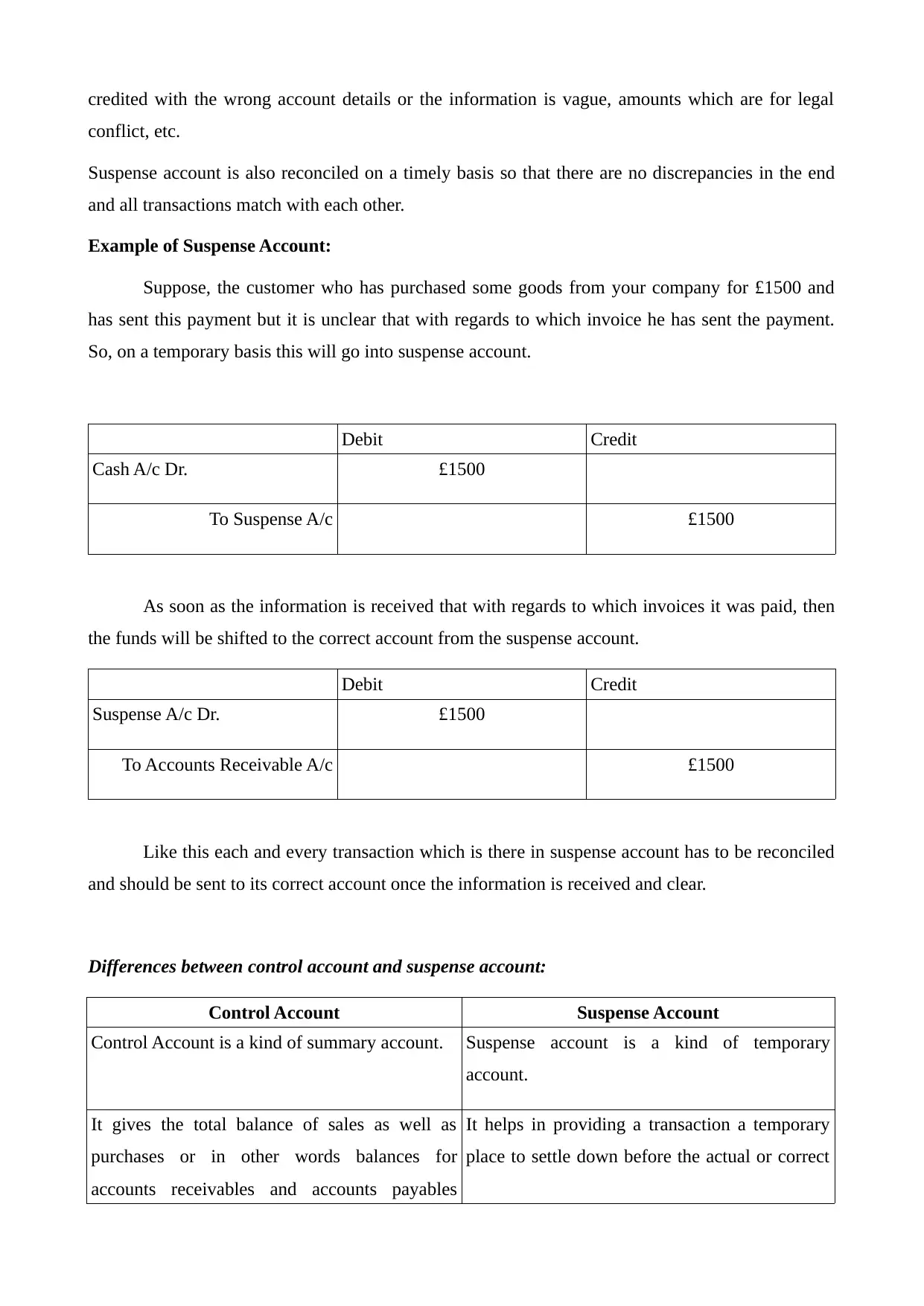
credited with the wrong account details or the information is vague, amounts which are for legal
conflict, etc.
Suspense account is also reconciled on a timely basis so that there are no discrepancies in the end
and all transactions match with each other.
Example of Suspense Account:
Suppose, the customer who has purchased some goods from your company for £1500 and
has sent this payment but it is unclear that with regards to which invoice he has sent the payment.
So, on a temporary basis this will go into suspense account.
Debit Credit
Cash A/c Dr. £1500
To Suspense A/c £1500
As soon as the information is received that with regards to which invoices it was paid, then
the funds will be shifted to the correct account from the suspense account.
Debit Credit
Suspense A/c Dr. £1500
To Accounts Receivable A/c £1500
Like this each and every transaction which is there in suspense account has to be reconciled
and should be sent to its correct account once the information is received and clear.
Differences between control account and suspense account:
Control Account Suspense Account
Control Account is a kind of summary account. Suspense account is a kind of temporary
account.
It gives the total balance of sales as well as
purchases or in other words balances for
accounts receivables and accounts payables
It helps in providing a transaction a temporary
place to settle down before the actual or correct
conflict, etc.
Suspense account is also reconciled on a timely basis so that there are no discrepancies in the end
and all transactions match with each other.
Example of Suspense Account:
Suppose, the customer who has purchased some goods from your company for £1500 and
has sent this payment but it is unclear that with regards to which invoice he has sent the payment.
So, on a temporary basis this will go into suspense account.
Debit Credit
Cash A/c Dr. £1500
To Suspense A/c £1500
As soon as the information is received that with regards to which invoices it was paid, then
the funds will be shifted to the correct account from the suspense account.
Debit Credit
Suspense A/c Dr. £1500
To Accounts Receivable A/c £1500
Like this each and every transaction which is there in suspense account has to be reconciled
and should be sent to its correct account once the information is received and clear.
Differences between control account and suspense account:
Control Account Suspense Account
Control Account is a kind of summary account. Suspense account is a kind of temporary
account.
It gives the total balance of sales as well as
purchases or in other words balances for
accounts receivables and accounts payables
It helps in providing a transaction a temporary
place to settle down before the actual or correct
Paraphrase This Document
Need a fresh take? Get an instant paraphrase of this document with our AI Paraphraser

(Glover, 2014). account is found for that.
It only deals with sales and purchases and no
other transactions can be put into this.
Suspense account can include anything for
which the information is not clear or the correct
account is difficult to find out.
CONCLUSION
To conclude, companies should do proper reporting of financial statements i.e. income
statement and balance sheet. It should be kept in mind that minimum errors are made so that when
reconciliation have to be done it will clearly match. Reconciliation is done so that errors can be
checked and final cash balance can be identified by the company. Management can take good
decisions if these accounts are maintained properly (De Waegenaere, Sansing and Wielhouwer,
2015).
REFERENCES
Books and Journals
Scott, W. R. and O'Brien, P. C., 2013. Financial accounting theory (Vol. 3). Toronto: Prentice Hall.
Edwards, J. R., 2013. A History of Financial Accounting (RLE Accounting). Routledge.
Warren, C. and Jones, J., 2018. Corporate financial accounting. Cengage Learning.
Weil, R. L., Schipper, K. and Francis, J., 2013. Financial accounting: an introduction to concepts,
methods and uses. Cengage Learning.
It only deals with sales and purchases and no
other transactions can be put into this.
Suspense account can include anything for
which the information is not clear or the correct
account is difficult to find out.
CONCLUSION
To conclude, companies should do proper reporting of financial statements i.e. income
statement and balance sheet. It should be kept in mind that minimum errors are made so that when
reconciliation have to be done it will clearly match. Reconciliation is done so that errors can be
checked and final cash balance can be identified by the company. Management can take good
decisions if these accounts are maintained properly (De Waegenaere, Sansing and Wielhouwer,
2015).
REFERENCES
Books and Journals
Scott, W. R. and O'Brien, P. C., 2013. Financial accounting theory (Vol. 3). Toronto: Prentice Hall.
Edwards, J. R., 2013. A History of Financial Accounting (RLE Accounting). Routledge.
Warren, C. and Jones, J., 2018. Corporate financial accounting. Cengage Learning.
Weil, R. L., Schipper, K. and Francis, J., 2013. Financial accounting: an introduction to concepts,
methods and uses. Cengage Learning.
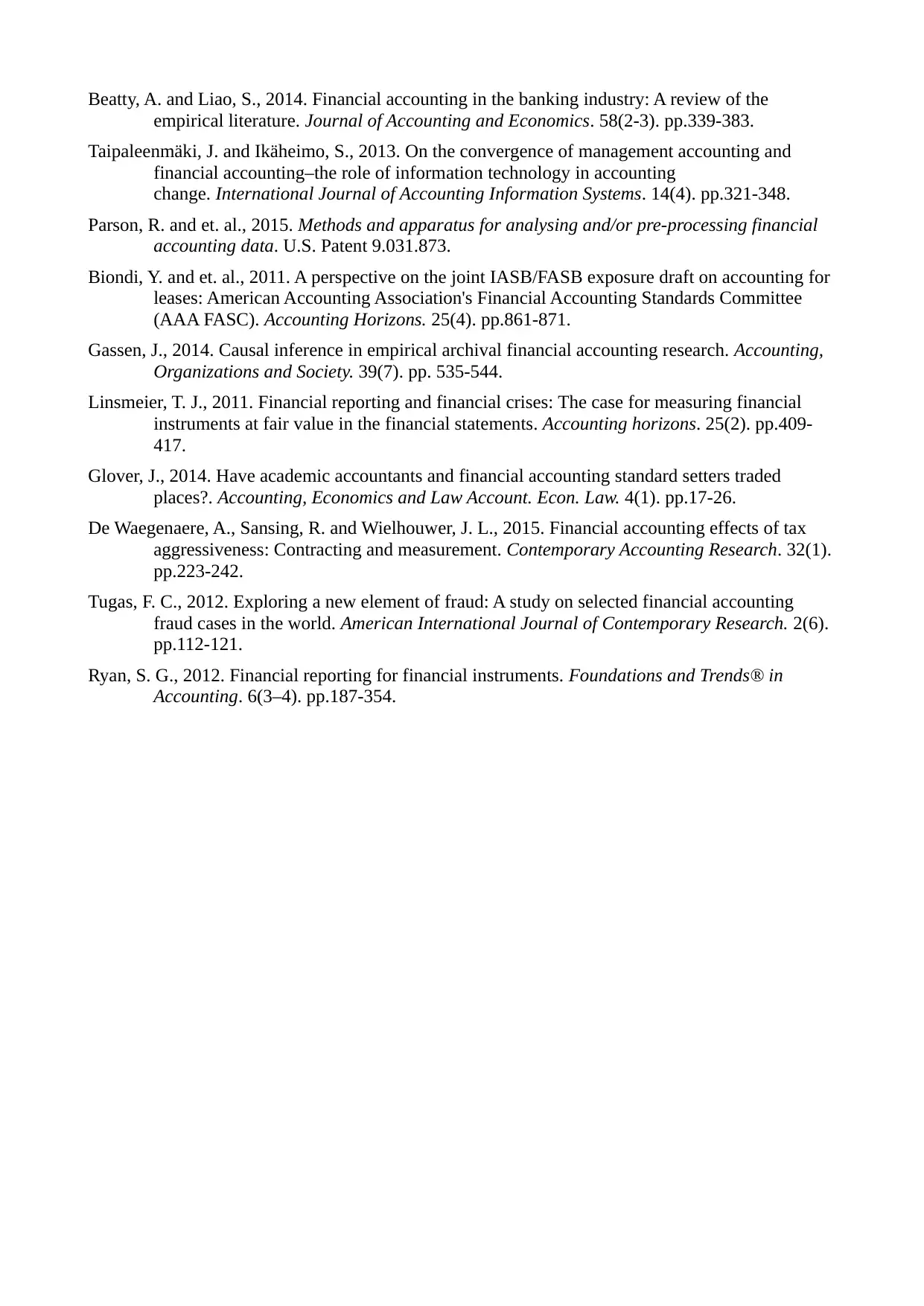
Beatty, A. and Liao, S., 2014. Financial accounting in the banking industry: A review of the
empirical literature. Journal of Accounting and Economics. 58(2-3). pp.339-383.
Taipaleenmäki, J. and Ikäheimo, S., 2013. On the convergence of management accounting and
financial accounting–the role of information technology in accounting
change. International Journal of Accounting Information Systems. 14(4). pp.321-348.
Parson, R. and et. al., 2015. Methods and apparatus for analysing and/or pre-processing financial
accounting data. U.S. Patent 9.031.873.
Biondi, Y. and et. al., 2011. A perspective on the joint IASB/FASB exposure draft on accounting for
leases: American Accounting Association's Financial Accounting Standards Committee
(AAA FASC). Accounting Horizons. 25(4). pp.861-871.
Gassen, J., 2014. Causal inference in empirical archival financial accounting research. Accounting,
Organizations and Society. 39(7). pp. 535-544.
Linsmeier, T. J., 2011. Financial reporting and financial crises: The case for measuring financial
instruments at fair value in the financial statements. Accounting horizons. 25(2). pp.409-
417.
Glover, J., 2014. Have academic accountants and financial accounting standard setters traded
places?. Accounting, Economics and Law Account. Econ. Law. 4(1). pp.17-26.
De Waegenaere, A., Sansing, R. and Wielhouwer, J. L., 2015. Financial accounting effects of tax
aggressiveness: Contracting and measurement. Contemporary Accounting Research. 32(1).
pp.223-242.
Tugas, F. C., 2012. Exploring a new element of fraud: A study on selected financial accounting
fraud cases in the world. American International Journal of Contemporary Research. 2(6).
pp.112-121.
Ryan, S. G., 2012. Financial reporting for financial instruments. Foundations and Trends® in
Accounting. 6(3–4). pp.187-354.
empirical literature. Journal of Accounting and Economics. 58(2-3). pp.339-383.
Taipaleenmäki, J. and Ikäheimo, S., 2013. On the convergence of management accounting and
financial accounting–the role of information technology in accounting
change. International Journal of Accounting Information Systems. 14(4). pp.321-348.
Parson, R. and et. al., 2015. Methods and apparatus for analysing and/or pre-processing financial
accounting data. U.S. Patent 9.031.873.
Biondi, Y. and et. al., 2011. A perspective on the joint IASB/FASB exposure draft on accounting for
leases: American Accounting Association's Financial Accounting Standards Committee
(AAA FASC). Accounting Horizons. 25(4). pp.861-871.
Gassen, J., 2014. Causal inference in empirical archival financial accounting research. Accounting,
Organizations and Society. 39(7). pp. 535-544.
Linsmeier, T. J., 2011. Financial reporting and financial crises: The case for measuring financial
instruments at fair value in the financial statements. Accounting horizons. 25(2). pp.409-
417.
Glover, J., 2014. Have academic accountants and financial accounting standard setters traded
places?. Accounting, Economics and Law Account. Econ. Law. 4(1). pp.17-26.
De Waegenaere, A., Sansing, R. and Wielhouwer, J. L., 2015. Financial accounting effects of tax
aggressiveness: Contracting and measurement. Contemporary Accounting Research. 32(1).
pp.223-242.
Tugas, F. C., 2012. Exploring a new element of fraud: A study on selected financial accounting
fraud cases in the world. American International Journal of Contemporary Research. 2(6).
pp.112-121.
Ryan, S. G., 2012. Financial reporting for financial instruments. Foundations and Trends® in
Accounting. 6(3–4). pp.187-354.
⊘ This is a preview!⊘
Do you want full access?
Subscribe today to unlock all pages.

Trusted by 1+ million students worldwide
1 out of 12
Related Documents
Your All-in-One AI-Powered Toolkit for Academic Success.
+13062052269
info@desklib.com
Available 24*7 on WhatsApp / Email
![[object Object]](/_next/static/media/star-bottom.7253800d.svg)
Unlock your academic potential
Copyright © 2020–2025 A2Z Services. All Rights Reserved. Developed and managed by ZUCOL.





